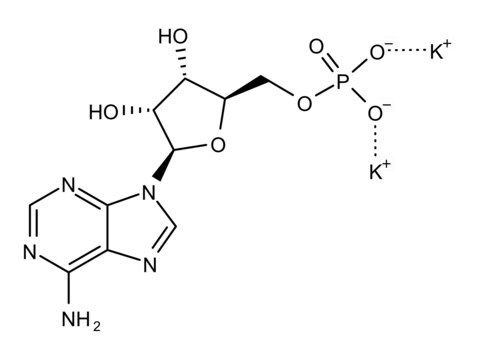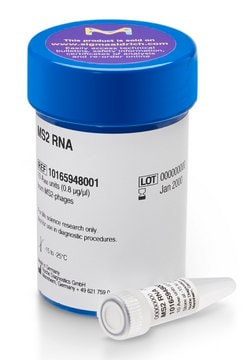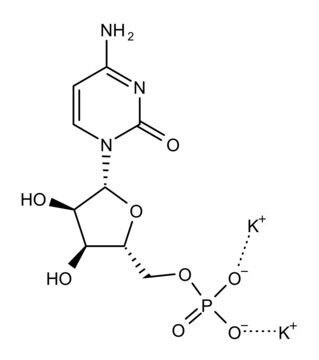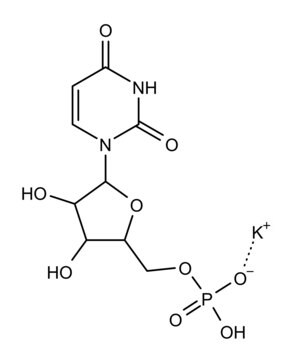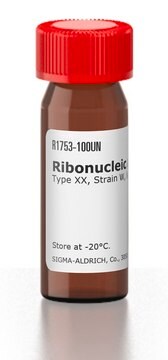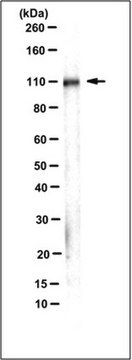おすすめの製品
詳細
Polyadenylic acid
品質水準
形状
lyophilized
分子量
700-3500 kDa
包装
pkg of 100 mg
メーカー/製品名
Roche
濃度
0.5 mg/mL (Working concentration)
テクニック
PCR: suitable
色
white
溶解性
water: soluble
吸光度比
A290/260 nm 0.03-0.05
A280/260 nm 0.28-0.32
A250/260 nm 0.86-0.90
保管温度
2-8°C
詳細
ポリ(A)はDNA及びRNAの定量的沈殿用キャリアーとして使用されます。
アプリケーション
ポリ(A)はdroplet digital PCR(ddPCR)アッセイに使用されています。
ポリアデニル酸[ポリ(A)]は、Exo1のエキソヌクレアーゼ活性を阻害します。また、凍結乾燥されたgBlockを再懸濁するための担体としても使用されています。
生物化学的/生理学的作用
3′末端に存在するポリアデニル酸[ポリ(A)]末端は、細胞核内で生成されます。哺乳動物細胞の場合、これには約250個のヌクレオチドが含まれます。ポリ(A)は、mRNAの分解と、翻訳の開始を調節します。細胞質ポリ(A)伸張は、翻訳を調節します。
品質
一般的分析:
モノヌクレオチド1ユニットに対してポリ(A)2.3 μmol/mg(吸光度より)。クロマトグラフィーで単一。
吸光度測定A250/A260、A280/A260、A290/A260
モノヌクレオチド1ユニットに対してポリ(A)2.3 μmol/mg(吸光度より)。クロマトグラフィーで単一。
吸光度測定A250/A260、A280/A260、A290/A260
シーケンス
鎖長2.100~10.000ヌクレオチド
単位の定義
A260 1ユニットは40μg ssDNA相当。
物理的形状
凍結乾燥粉末、カリウム塩
調製ノート
作業濃度:0.5 mg/mL
0.5 mg/mLが推奨されます。
標準溶液:0.5 mg/mLが推奨されます。
0.5 mg/mLが推奨されます。
標準溶液:0.5 mg/mLが推奨されます。
その他情報
ライフサイエンス研究専用。診断目的での使用はできません。
保管分類コード
11 - Combustible Solids
WGK
WGK 1
引火点(°F)
Not applicable
引火点(℃)
Not applicable
試験成績書(COA)
製品のロット番号・バッチ番号を入力して、試験成績書(COA) を検索できます。ロット番号・バッチ番号は、製品ラベルに「Lot」または「Batch」に続いて記載されています。
Poly (A) tail length is controlled by the nuclear poly (A)-binding protein regulating the interaction between poly (A) polymerase and the cleavage and polyadenylation specificity factor
Kuhn U, et al.
The Journal of Biological Chemistry, 284(34), 22803-22814 (2009)
Yuichiro Miyaoka et al.
Scientific reports, 6, 23549-23549 (2016-04-01)
Precise genome-editing relies on the repair of sequence-specific nuclease-induced DNA nicking or double-strand breaks (DSBs) by homology-directed repair (HDR). However, nonhomologous end-joining (NHEJ), an error-prone repair, acts concurrently, reducing the rate of high-fidelity edits. The identification of genome-editing conditions that
Poly (ADP-ribose)-binding promotes Exo1 damage recruitment and suppresses its nuclease activities
Cheruiyot A, et al.
DNA Repair, 35, 106-115 (2015)
Peiguo Yang et al.
Cell, 181(2), 325-345 (2020-04-18)
The mechanisms underlying ribonucleoprotein (RNP) granule assembly, including the basis for establishing and maintaining RNP granules with distinct composition, are unknown. One prominent type of RNP granule is the stress granule (SG), a dynamic and reversible cytoplasmic assembly formed in
ライフサイエンス、有機合成、材料科学、クロマトグラフィー、分析など、あらゆる分野の研究に経験のあるメンバーがおります。.
製品に関するお問い合わせはこちら(テクニカルサービス)